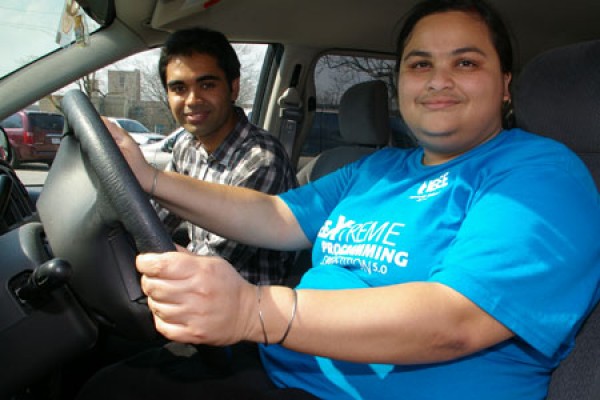Motorists in the future may be able to help cut down on drunk-driving statistics thanks to a unique face-recognition program developed by a pair of University of Windsor engineering graduate students.
Although it’s still a long way from being available in vehicles, the Driver ID device would work in conjunction with technology that could be incorporated into steering wheels that would detect the level of alcohol in a driver’s blood, according to John Carroll, chief technology officer at the Waterloo-based Sober Steering Incorporated.
“It’s a pre-prototype and still very much a proof of concept,” said Carroll, whose company was one of seven small to medium-sized businesses to receive funding in 2010 from the FedDev Applied Research and Commercialization Initiative to work with UWindsor researchers on turning ideas into commercially viable goods. “It would have to be miniaturized before it could be put into a vehicle.”
Carroll’s company has developed technology which would see transdermal sensors built into a steering wheel that would detect a driver’s blood alcohol level when they placed their hands on the wheel by analyzing the gas coming from their palms. If their level exceeded a pre-set limit, the individual would not be allowed to drive the car. His company is currently in the process of developing the technology, with the goal of someday making it available for manufacturers to build into their vehicles.

Jonathan Wu. |
However the company needed to address the problem of what to do if someone attempted to trick the system by getting another sober person to sit in the driver’s seat, put their hands on the wheel and try to start the vehicle.
PhD student Ashirbani Saha and Master’s student Kaushik Ray, who both work in electrical and computer engineering professor Jonathan Wu’s lab, developed an algorithm for a face recognition system that would work in concert with the sober steering sensors by authenticating the identity of the driver.
Under that system, only authorized individuals at permissible blood-alcohol levels would be allowed to drive the car and its owner would have ultimate control over who is permitted to drive it. They would take pictures of authorized drivers and store them in the system’s database. A small, infrared camera mounted somewhere in the vehicle would snap a photo of whoever is sitting behind the wheel and compare it to the images stored in the database. The system also checks periodically to verify who is driving.
“If the person is not in the database, they will not be allowed to drive the car, so in that way, it will also help prevent auto theft,” said Ray. “This will actually help save people’s lives. The person who drives drunk, not only is he risking his own life, but the lives of his passengers and other people on the road.”
Saha said it was very rewarding to work with a real company on a project as important as this one.
“It’s really gratifying to know that I’ve been able to contribute to something in the field of application,” said Saha.
Carroll said he was delighted with the results.
“It was excellent,” he said. “They’re a very talented team that we worked with. In the end, they came up with a system that works very well.”

